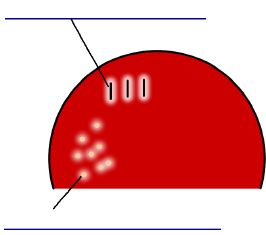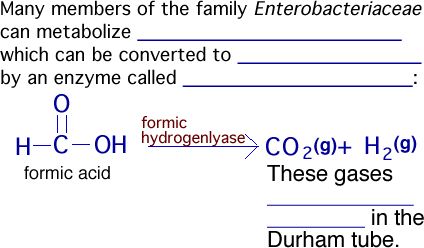Lecture #16: Enzyme-Mediated Biochemical Activities of Bacteria: Physiological Testing II
Biochemical tests for Gram-positive cocci:
I. Blood Agar Plates (BAP)
Review: What three types of hemolysis can be observed on a BAP plate?
See
the
Summary of Biochemical Techniques (BAP)
A. Throat swabs (may) contain:
1. Streptococcus mitis – _________________________________,
___________________________________ in the throat and
mouth
2. _________________________________
“oral streptococci”
2. Streptococcus pyogenes -________________________________
____________________________________
4. Staphylococcus aureus –_________________________________,
harbored by some in the pharyngeal area
*Further differentiation between bacteria seen on the swabs is necessary
to determine disease causing potential and ______________________
________________________.
B. The streak-stab technique
1. The stab allows us to detect ______________________________,
which is a specific hemolysin produced by Streptococcus pyogenes.
This hemolysin is _______________________________________
and thus is only seen in anaerobic environments (stab bottom).
2. Streptococcus pyogenes also produces _______________________,
which is a hemolysin that causes b-hemolysis in an
_______________ environment. This is easily seen around
a single colony on the surface of the plate.

See
the Summary of Biochemical Techniques (streak-stab technique)
II. Mannitol Salt Agar (MSA) Plate
Review: Which organism, Staphylococcus aureus or Streptococcus
mitis, would grow on an MSA plate? ____________________________________________
Review: What color would an MSA plate be if the organism streaked on it was
able to ferment mannitol? ____________________________
See
the
Summary of Biochemical Techniques (MSA)
III. Catalase Test
A. Catalase is an enzyme that breaks down toxic H202
into H2O and O2 gas.

B. A positive result is indicated by the production of _________________
____________________________.
Review: Members of which two genera are catalase positive? ______________________
______________________
Review: Members of which two genera are catalase negative? ______________________
______________________
See
the
Summary of Biochemical Techniques (catalase test)
IV. Coagulase Test
A. Coagulase is an enzyme that can ______________
or coagulate human or rabbit______________________.
B. Used to differentiate between S. aureus ____________________________
and other Staphs _______________________________.
See
the
Summary of Biochemical Techniques (coagulase test)
V. Taxos Testing (Antibiotic Resistance)
A. ____________________ is a disc
inoculated with __________________.
This antibiotic is used to differentiate between a-hemolytic strains.
1. Nonpathogenic normal flora, S. mitis, shows _________________
_____________________________.
2. Pathogenic S. pneumoniae is ______________________________
and will show a large zone of inhibition.
See
the
Summary of Biochemical Techniques (Taxos P)
B. ____________________ is a
disc inoculated with ___________________.
This is an antibiotic used to differentiate between b-hemolytic strains.
1. Streptococcus pyogenes is _______________________.
2. Streptococcus agalactiae is _______________________.
If an organism shows a zone of inhibition in the presence of Taxos
A, is it capable of causing “strep throat”? ____________
See
the
Summary of Biochemical Techniques (Taxos A)
VI. Bile Esculin Agar
A. Is a ________________________________________
medium used to identify the Enterococcus spp. (Enterococcus faecium
and Enterococcus faecalis).
B. ______________ inhibits the
growth of most Gram-positives (enterococci excepted). Sodium azide inhibits
the growth of _______________________.
C. The differential ingredient is esculin. If an organism can hydrolyze esculin
in the presence of bile, the product esculetin is formed. Esculetin reacts
with the medium turning the slant _____________________________________.
See
the
Summary of Biochemical Techniques (bile esculin agar)
Biochemical tests for Gram-negative bacilli:
I. MacConkey Agar
A. _________________________________________Medium
B. Bile salts inhibit the growth of _________________________
organisms.
C. If the bacteria are able to ferment lactose, the acid produced will cause
the pH indicator to ________________________________________________
_______________________________.
See
the
Summary of Biochemical Techniques (MacConkey agar)
II. Glucose Tubes
A. Review: Is the organism used to inoculate this glucose tube capable
of fermenting the sugar glucose?

B. A bubble in the Durham tube indicates that gas has been produced:

See
the
Summary of Biochemical Techniques (Glucose tubes)
III. SIM Tube
Review: What will be the appearance of a SIM tube if it is inoculated
with an organism that produces H2S? _____________________________________
H2S is produced either through the _____________________________________
by an enzyme called cysteine desulfurase or by the _________________________
___________________ during anaerobic respiration.
Review: What are the two other things detected by SIM medium? _______________________________
__________________________________
See
the
Summary of Biochemical Techniques (SIM)
IV. KIA (Kligler’s Iron Agar)
A differential medium that contains two sugars: __________________
(low conc.) and _________________________
(higher conc.).
A. Fermenters will typically utilize the _______________________
and production of acidic fermentation byproducts will cause the entire tube
to turn ______________________.
However, the glucose is in short supply and after the first few hours of growth
will be all used up.
B. After the glucose is gone, bacteria that are capable of fermenting lactose
will do so. Production of acidic byproducts will continue and the medium will
_____________________________________.
What will a KIA tube look like if the organism can ferment both glucose
and lactose? _________________________________________________
C. Bacteria that are incapable of fermenting lactose have to utilize the ______________________________________
in the medium. This produces NH3 (a weak base), which ______________________________
and turns the slant red. The butt remains yellow.
What will a KIA tube look like if the organism can ferment glucose but
not lactose? ________________________________________________
D. Nonfermenters will utilize only the amino acids and proteins in the medium.
The slant will be ___________ and
the butt will remain the original red/orange color.
What will a KIA tube like if the organism can ferment neither glucose
nor lactose? ____________________________________________________
E. H2S production –The reduction of sulfate to hydrogen sulfide
results in a _____________________
precipitate.
See
the
Summary of Biochemical Techniques (KIA)
V. Oxidase Test
A. Detects the enzyme ______________________________________,
an important catalyst in the electron transport chain of some organisms.
B. Smear a colony onto filter paper and add Oxidase reagent. If the bacteria
produces cytochrome oxidase, the colony will turn ____________________
_________________________.
C. Pseudomonas and Neisseria are oxidase _____________________.
See
the Summary of Biochemical Techniques (Oxidase test)
*Note - a positive and negative _______________________
should be performed every time the oxidase test is done.
VI. Urease Test
A. Urea broth is used to test for the enzyme urease. ___________________
______________________________________. Since ammonia (NH3)
is alkaline, the pH indicator will produce a ____________________________
_______________.
B. Members of the genus ___________________
are urease positive.
See
the Summary of Biochemical Techniques (Urease test)
|



